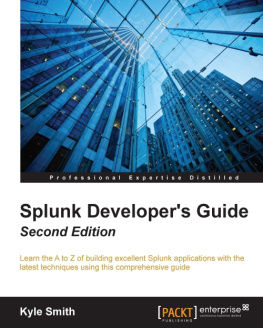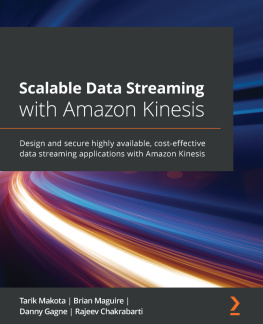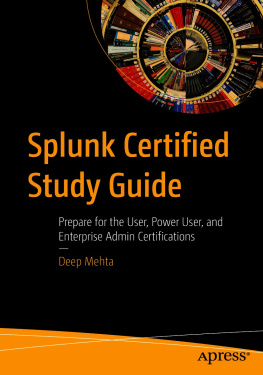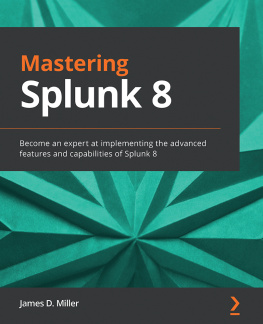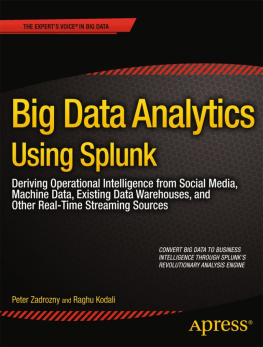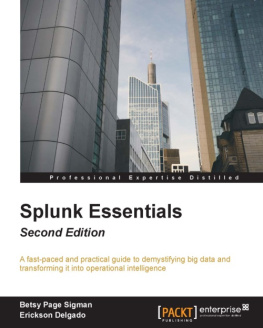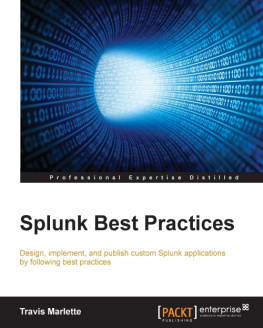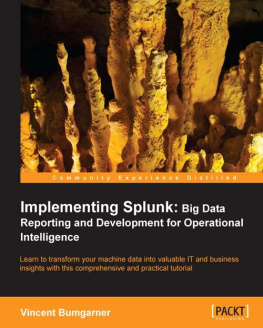Kyle Smith - Splunk Developers Guide
Here you can read online Kyle Smith - Splunk Developers Guide full text of the book (entire story) in english for free. Download pdf and epub, get meaning, cover and reviews about this ebook. year: 2016, publisher: Packt Publishing, genre: Computer. Description of the work, (preface) as well as reviews are available. Best literature library LitArk.com created for fans of good reading and offers a wide selection of genres:
Romance novel
Science fiction
Adventure
Detective
Science
History
Home and family
Prose
Art
Politics
Computer
Non-fiction
Religion
Business
Children
Humor
Choose a favorite category and find really read worthwhile books. Enjoy immersion in the world of imagination, feel the emotions of the characters or learn something new for yourself, make an fascinating discovery.
- Book:Splunk Developers Guide
- Author:
- Publisher:Packt Publishing
- Genre:
- Year:2016
- Rating:4 / 5
- Favourites:Add to favourites
- Your mark:
Splunk Developers Guide: summary, description and annotation
We offer to read an annotation, description, summary or preface (depends on what the author of the book "Splunk Developers Guide" wrote himself). If you haven't found the necessary information about the book — write in the comments, we will try to find it.
- This is the most up-to-date book on Splunk 6.3 for developers
- Get ahead of being just a Splunk user and start creating custom Splunk applications as per your needs
- Your one-stop-solution to Splunk application development
Splunk provides a platform that allows you to search data stored on a machine, analyze it, and visualize the analyzed data to make informed decisions. The adoption of Splunk in enterprises is huge, and it has a wide range of customers right from Adobe to Dominos. Using the Splunk platform as a user is one thing, but customizing this platform and creating applications specific to your needs takes more than basic knowledge of the platform.
This book will dive into developing Splunk applications that cater to your needs of making sense of data and will let you visualize this data with the help of stunning dashboards.
This book includes everything on developing a full-fledged Splunk application right from designing to implementing to publishing. We will design the fundamentals to build a Splunk application and then move on to creating one. During the course of the book, we will cover application data, objects, permissions, and more. After this, we will show you how to enhance the application, including branding, workflows, and enriched data. Views, dashboards, and web frameworks are also covered.
This book will showcase everything new in the latest version of Splunk including the latest data models, alert actions, XML forms, various dashboard enhancements, and visualization options (with D3). Finally, we take a look at the latest Splunk cloud applications, advanced integrations, and development as per the latest release.
What you will learn- Implement a Modular Input and a custom D3 data visualization
- Create a directory structure and set view permissions
- Create a search view and a dashboard view using advanced XML modules
- Enhance your application using eventtypes, tags, and macros
- Package a Splunk application using best practices
- Publish a Splunk application to the Splunk community
Kyle Smith is a self-proclaimed geek and has been working with Splunk extensively since 2010. He enjoys integrating Splunk with new sources of data and types of visualization. He has spoken numerous times at the Splunk User Conference (most recently in 2014 on Lesser Known Search Commands) and is an active contributor to the Splunk Answers community and also to the #splunk IRC channel. He was awarded membership into the SplunkTrust as a founding member. He has published several Splunk Apps and add-ons to Splunkbase, the Splunk communitys premier Apps and add-ons platform. He has worked in both higher education and private industry; he is currently working as an integration developer for Splunks longest running professional services partner. He lives in central Pennsylvania with his family.
Table of Contents- Application Design Fundamentals
- Creating Applications
- Enhancing Applications
- Basic Views and Dashboards
- The Splunk Web Framework
- Advanced Integrations and Development
- Packaging Applications
- Publishing Applications
Kyle Smith: author's other books
Who wrote Splunk Developers Guide? Find out the surname, the name of the author of the book and a list of all author's works by series.

